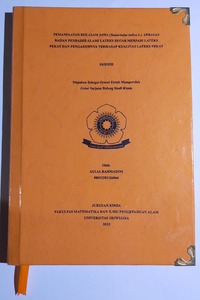RAHMADINI, AULIA and Fanani, Zainal (2025) PEMANFAATAN BIJI ASAM JAWA (Tamarindus indica L.) SEBAGAI BAHAN PENDADIH ALAMI LATEKS SEGAR MENJADI LATEKS PEKAT DAN PENGARUHNYA TERHADAP KUALITAS LATEKS PEKAT. Undergraduate thesis, Sriwijaya University.
![[thumbnail of RAMA_47201_08031282126066_cover.jpeg]](http://repository.unsri.ac.id/173987/19.hassmallThumbnailVersion/RAMA_47201_08031282126066_cover.jpeg)  Preview |
Image
RAMA_47201_08031282126066_cover.jpeg - Accepted Version Available under License Creative Commons Public Domain Dedication. Download (322kB) | Preview |
|
Text
RAMA_47201_08031282126066.pdf - Accepted Version Restricted to Repository staff only Available under License Creative Commons Public Domain Dedication. Download (2MB) | Request a copy |
|
|
Text
RAMA_47201_08031282126066_TURNITIN.pdf - Accepted Version Restricted to Repository staff only Available under License Creative Commons Public Domain Dedication. Download (3MB) | Request a copy |
|
|
Text
RAMA_47201_08031282126066_0021086701_01_front_ref.pdf - Accepted Version Available under License Creative Commons Public Domain Dedication. Download (1MB) |
|
|
Text
RAMA_47201_08031282126066_0021086701_02.pdf - Accepted Version Restricted to Repository staff only Available under License Creative Commons Public Domain Dedication. Download (456kB) | Request a copy |
|
|
Text
RAMA_47201_08031282126066_0021086701_03.pdf - Accepted Version Restricted to Repository staff only Available under License Creative Commons Public Domain Dedication. Download (251kB) | Request a copy |
|
|
Text
RAMA_47201_08031282126066_0021086701_04.pdf - Accepted Version Restricted to Repository staff only Available under License Creative Commons Public Domain Dedication. Download (322kB) | Request a copy |
|
|
Text
RAMA_47201_08031282126066_0021086701_05.pdf - Accepted Version Restricted to Repository staff only Available under License Creative Commons Public Domain Dedication. Download (141kB) | Request a copy |
|
|
Text
RAMA_47201_08031282126066_0021086701_06_ref.pdf - Bibliography Restricted to Repository staff only Available under License Creative Commons Public Domain Dedication. Download (211kB) | Request a copy |
|
|
Text
RAMA_47201_08031282126066_0021086701_07_lamp.pdf - Accepted Version Restricted to Repository staff only Available under License Creative Commons Public Domain Dedication. Download (754kB) | Request a copy |
Abstract
Rubber latex is produced through tapping rubber trees and is usually sold in the form of lumps or rubber lumps. These rubber lumps have low quality and cannot be directly processed by the community to become finished products such as for making gloves, rubber bands, foam mattresses and others. To become these products, rubber latex is usually processed into concentrated latex. Concentrated latex can be obtained through a creaming process by adding creaming agents such as carboxymethyl cellulose (CMC) and alginate and ammonia. The use of synthetic creaming agents needs to be reduced and replaced with natural creaming agents. The purpose of the study was to determine the ability of tamarind seeds as a natural creaming agent in the process of making concentrated latex. This study began with sample preparation in the form of tamarind seeds. Tamarind seeds were then subjected to preliminary tests through variations in concentrations of 6, 12, 24% then heated (100˚C) and without heating. The results showed that heating was better than without heating and low concentrations were better. Based on preliminary tests to obtain optimal results, concentration variations were carried out, namely, 3, 6, 8, 10% with heating treatment. Optimization through concentration variations determined the quality by measuring the dry rubber content (DRC) and the best results were obtained using a concentration of 6% with DRC of 56%. The next treatment, concentrated latex was increased at a concentration of 6% with heating and the results were compared with concentrated latex produced using a combination of carboxymethyl cellulose (CMC) and alginate creaming materials. The quality of latex produced from both was determined from the measurement of dry rubber content (DRC), total solids content (TSC), and volatile fatty acids (VFA). The results of the quality test of concentrated latex with tamarind seed curdling materials, obtained DRC of 57%, TSC of 61%, and VFA number of 0.060% w / w while, the combination of CMC and alginate, obtained DRC of 63%, TSC of 62%, and VFA number of 0.063% w / w. Based on the results of quality tests, only the VFA number in concentrated latex with tamarind seed creaming material meets SNI ISO 2004:2017. Concentrated latex with CMC and alginate creaming materials has better concentrated latex quality compared to concentrated latex with tamarind seed creaming material.
| Item Type: | Thesis (Undergraduate) |
|---|---|
| Uncontrolled Keywords: | Biji asam jawa (Tamarindus indica L.), bahan pendadih, lateks pekat, Kadar karet kering, pendadihan |
| Subjects: | Q Science > QD Chemistry > QD450-801 Physical and theoretical chemistry |
| Divisions: | 08-Faculty of Mathematics and Natural Science > 47201-Chemistry (S1) |
| Depositing User: | Aulia Rahmadini |
| Date Deposited: | 25 May 2025 02:28 |
| Last Modified: | 25 May 2025 02:28 |
| URI: | http://repository.unsri.ac.id/id/eprint/173987 |
Actions (login required)
 |
View Item |
